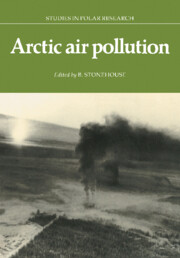Book contents
- Frontmatter
- Contents
- CONTRIBUTORS TO THIS VOLUME
- FOREWORD
- INTRODUCTION: INTERNATIONAL SYMPOSIUM ON ARCTIC AIR POLLUTION
- Part 1 Composition, source areas and transport pathways
- Part 2 Local, regional, global, ecological and climatic implications
- Part 3 Health and ecological issues
- Part 4 International cooperation and state responsibility
- 5 Conclusions
- Conclusions from the Arctic Atmospheric Pollution Conference
- Index
Conclusions from the Arctic Atmospheric Pollution Conference
Published online by Cambridge University Press: 03 May 2010
- Frontmatter
- Contents
- CONTRIBUTORS TO THIS VOLUME
- FOREWORD
- INTRODUCTION: INTERNATIONAL SYMPOSIUM ON ARCTIC AIR POLLUTION
- Part 1 Composition, source areas and transport pathways
- Part 2 Local, regional, global, ecological and climatic implications
- Part 3 Health and ecological issues
- Part 4 International cooperation and state responsibility
- 5 Conclusions
- Conclusions from the Arctic Atmospheric Pollution Conference
- Index
Summary
ABSTRACT. There is clear evidence that an atmospheric transport of pollutants to the Arctic takes place from the industrialized areas of surrounding continents, particularly in late winter when the anthropogenic component may rise to levels ten times higher than in summer and SO4 concentrations are between 1.5 and 4.0 μg/m3. In Alaska pH in snow has changed from 5.5 to 4.9 in the last 20 years. The basic meteorological cause for high levels of local and long-range pollutants in the Arctic in late winter is the lack of solar radiation, which contributes to high stability of air. Emission inventories, statistical analyses of trace elements and trajectory model calculations indicate that most winter aerosol at levels below 2 km originates in Europe and western and central Asia. The origin of pollution at higher levels is still unknown. Proposals for further monitoring and research are presented.
Studies of ice cores have indicated a marked increase in air pollution levels in this century, particularly since the mid–1950s.
The radiation balance over the Arctic could be significantly modified by aerosols like graphitic carbon particles which are common in arctic air pollution. Aerosols increase absorption of solar energy in the atmosphere and decrease absorption on the ground. In March they cause a mean atmospheric heating rate of the order of 0.20 K day−1 at latitudes 70° to 75°N. Proposals are presented for monitoring and research to determine more precisely the impact of changes in the radiation balance on regional climate in the Arctic.
- Type
- Chapter
- Information
- Arctic Air Pollution , pp. 309 - 320Publisher: Cambridge University PressPrint publication year: 1987



